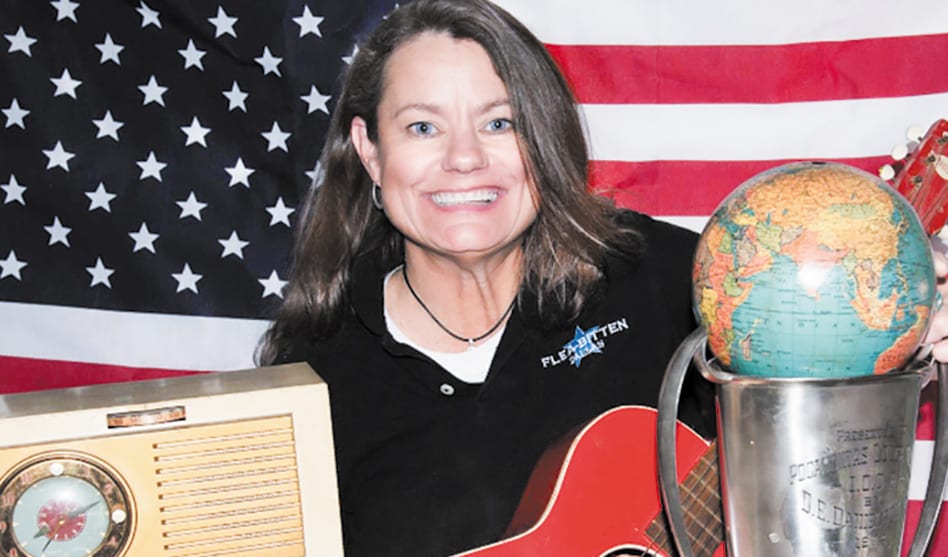Kellye Hollis
Kellye Hollis gives someone’s old items new lives through her estate sale business
DAVID TAFFET | Senior Staff Writer
taffet@dallasvoice.com
One of the strangest things Kellye Hollis has ever sold in the four years she has been running estate sales, she said, was a taxidermied badger. Not only was the badger an odd item, Hollis found it just as odd that it was one of the first items purchased once the doors opened for the sake.
Then there was the doctor’s bag with, “umm … peculiar contents that sold earlier than I would have expected,” she noted.
Some business owners spend years planning to go into business for themselves. Not Hollis; she jumped right in. Soon after leaving her corporate career, she said she received three calls within a 48-hour period from people asking her to plan their estate sales. All three of those sales were successful, and Hollis was in the estate sale business.
She began her professional life as a corporate event planner. As a hobby, she rented space at antique malls, including Love Field Antique Mall, and would “do a little junkin’ whenever I could,” Hollis said. She’d pick up items at estate sales, clean them up, create vignettes to make them more attractive and sell them in her retail space.
Then four years ago, Hollis said, she “decided to see what would happen out on my own.” So she stepped away from the corporate life and stepped into her business.
And so Kellye Hollis Estate Sales was born.
She realized she needed a sign, a logo and cards, so “I whipped into Fast Signs and told them I want a logo with something to do with an old typewriter,” she said.
Selling an estate
An estate sale, Hollis explained, is when the homeowner wants to sell everything in the house. Sometimes the person is moving and will be completely redecorating.
Sometimes the client is cleaning out the home of a relative who died. And some of her customers are people downsizing from a large house into an apartment or a much smaller assisted living unit.
“Sometimes I go into the attic and bring out stuff they didn’t even know they had,” Hollis said. And sometimes she rearranges items to make them more attractive, leaving the surprised homeowner to ask where those things even came from.
One of the more interesting houses Hollis has worked with was a home built for the Texas Centennial Exhibition at Fair Park. After the fair, the house was moved.
“Mid-century anything” is hot right now, Hollis said, while antiques and fine china aren’t as popular right now with buyers.
Actually, Hollis corrected herself, some china is selling well — some of the plainer styles, at least. But the more ornate patterns aren’t moving, she said.
Much of Hollis’ business comes from friends, because going into someone’s house to sort through, arrange and price their personal items take trust. “I’m blessed with friends referring me,” she said.
But Hollis also gets business from people who’ve been to one of her sales, liked what they saw and took her business card when they left.
Most sales last only three days, so pricing is of utmost importance. Hollis said she prices items to sell in three days, but on rare occasions — with very large houses overloaded with things to sell — she does a two-weekend sale.
Most sales open on a Friday, and that’s the day, Hollis said, that she expects dealer sales. Saturday is the biggest individual customer day. And the goal for Sunday is to have everything gone by that evening evening, so everything’s marked half-price, and it’s the bargain hunters who turn out that last day.
But having something left at the end of Sunday is usually inevitable, so Hollis has an exit strategy: Usually leftover items are donated, or someone may do a buyout of the remainder to sell elsewhere in another format, she said.
For buyers who purchased furniture and other large pieces, Hollis is around a couple more days for pickups.
Presentation, Hollis said, is what sells things. But so does price, so an extensive knowledge of what things are worth to estate sale buyers is vital. “We know what we can get for an ironing board or for glassware,” Hollis said.
For some items, she relies on websites like eBay to help with pricing. With artwork, Hollis talks to experts who can advise her on how the artist is selling, what galleries represent the artist, and how well that person’s works move in general.
Hollis also gets expert advice on pricing jewelry, and since jewelry, especially the smaller pieces, is what’s most likely to just “walk off,” she tends to sell much of the jewelry and sterling silver items in other ways.
Before setting up a house for a sale, Hollis has a very important question for the seller: “Is there anything you’re going to regret selling?” If they answer yes, especially with items that have sentimental value, she tells them, “Keep it.”
She also has to employ some tact to make sure that the best items are available for sale, and aren’t overwhelmed by less sellable items. When that is the case, she said, she’ll suggest to the seller that, “We’re going to need to clear out some of the less desirable items to make the others shine.”
While china and crystal don’t sell well, drinking glasses and dishes do. Anything that goes in an in-home bar, Hollis said, is very popular right now. While traditional antique furniture isn’t selling well, mid-century pieces fly off the sales floor.
Hollis advertises in EstateSales.net and expects 1,000 or more people to attend her sales through the weekend. Often, she said, there’s a line down the walk when she opens for business in the morning.
That’s how she knows the weekend will be a successful one.
For more information, visit KellyeHollisEstateSales.com.










